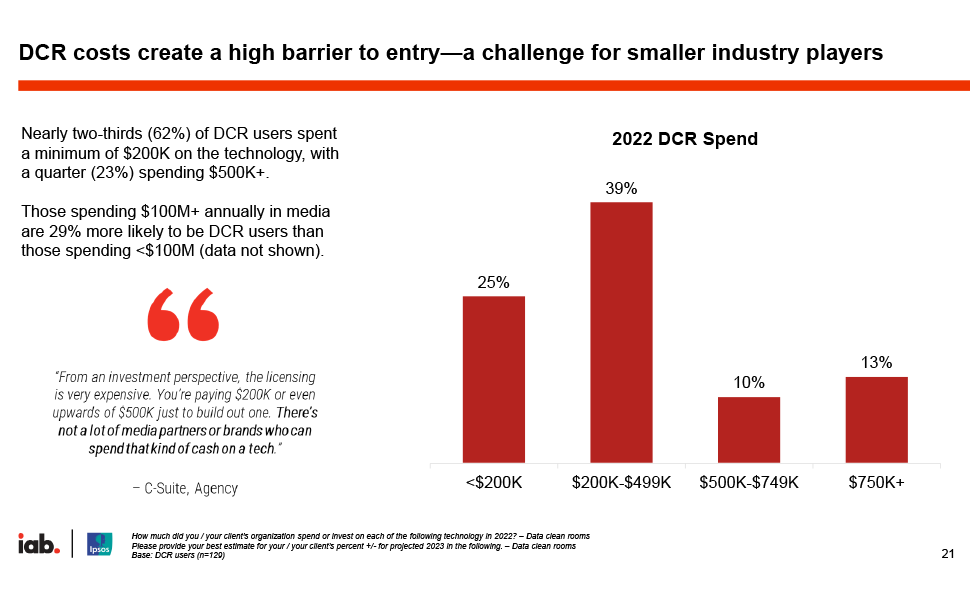
Data Clean Rooms: Why All the Fuss?
If you’re a marketer and you are subscribed to any trade media, have attended conferences or participated in webinars within the last year, then you have likely heard the term ‘clean room’. A recent IAB study (State of Data 2023) indicates that the adoption of clean rooms has accelerated dramatically over the past two years (faster than any other identity-solution technology), and Gartner states that current users of clean rooms are expected to increase their spending on these initiatives by 29% this year.*
Despite the momentum behind clean rooms, the concept is not entirely clear to many marketers and certainly not the extent of the possibilities, the challenges and the considerations that are implicit in a clean room initiative.
Let’s start at the beginning: what is a clean room and why is it needed?
At the most basic level, a clean room is a secure, privacy-compliant environment that allows two or more parties to collaborate using their first-party data. This environment enables the parties to benefit from the insights and potential actions derived through the data collaboration while maintaining the privacy and control of those data. With key market dynamics such as disappearing third-party cookies, the deprecation of location signals for targeting, and tightening privacy regulations, clean rooms are an increasingly essential component of the marketing toolkit for leveraging first-party data.
More specifically, clean rooms provide key benefits to multiple stakeholders:
For Advertisers & Brands – The opportunity to leverage first-party, consent-based data assets in a privacy-preserving environment to find common customers and insights across organizations, identify and activate audiences in media platforms, and provide cross-channel measurement and attribution (including transactional lift).

For Agencies - More effective planning and audience targeting based on attributable media consumption and other behaviours, Return on Ad Spend (ROAS) measurement, and media/market mix modelling and optimization.

For Publishers & Media Owners – Monetization of their permissioned subscribers and media assets, the ability to scale audiences for Advertisers, and use of log/campaign files for media spend transparency and closed-loop attribution.
Truly, the outcomes that clean rooms can offer within today’s dynamic marketing ecosystem are significant. However, taking full advantage of such environments is not without its challenges. Organizations of all stripes – whether brands, agencies, publishers or other – need to be aware of several key considerations as they embark on their clean room journey, with particular attention as to whether they want to ‘build’ or ‘buy’ such services.
- More than technology: A common misunderstanding of clean rooms is that they are a turnkey technology platform – simply install, and the full range of data collaboration benefits are immediately at one’s disposal. This could not be further from the truth. Clean rooms are complex environments that are certainly technology-enabled but require a broad range of competencies in data privacy and security, access to identity solutions, data management and matching expertise, analytics, availability of third-party data partners, and connectivity to media platforms, to name a few.
- Significant investment required: Beyond its multifaceted complexity, a clean room requires considerable investment to realize its potential. This includes not just financial investment but the right talent, processes, data processing, connectivity and interoperability, and more. The IAB State of Data 2023 study shows that nearly two-thirds (62%) of users spent a minimum of USD$200K in clean rooms in 2022, with a quarter (23%) spending more than USD$500K. (Note: while clean room pricing will vary by use case and complexity, EA provides clean room opportunities for as little as CDN$20K)
- All about the data: Anyone involved in data management and analytics knows that the quality of the output is only as good as the quality of the data going in. The same adage applies to clean rooms, which require comprehensive data onboarding, including auditing, verification and cleansing processes to make the data usable and maximize match rates when using both deterministic and probabilistic matching methodologies (the latter of which requires its own set of expert routines and workflows).
- Process management: As is evident from the above, end-to-end management of clean room services are complex and resource intensive. Given that most organizations do not possess the core competencies, the investment appetite or the internal capacity for this kind of focus, jumping into a clean room build needs to be considered very carefully. A safer, more cost-effective alternative – even to prove out the value proposition – is to select a full-service provider who has the experience, data resources and processes to deliver desired outcomes more immediately and with less ‘friction’.
- A uniquely Canadian focus: Canadian marketers and business strategists understand that there are unique and important aspects governing the national landscape. These include Canada-specific privacy regulations (with Bill C-27 legislation pending), public availability (or lack thereof) of certain consumer data and identity graphs compared to the U.S., regionally-specific cultural differences, third-party data sources and media connectivity, among others. For Canadian-based organizations, it is imperative that a clean room solution factor in these considerations rather than assuming that a global platform will work seamlessly in this environment.


The marketing industry is at an inflection point, faced with strengthening privacy regulations, disappearing third-party cookies and the loss of location signals from mobile data. The emergence of clean rooms offers a practical and privacy-compliant opportunity for advertisers, publishers, agencies and media companies to collaborate. When done right, the potential is enormous – from audience enrichment to targeted campaign activation to transaction-based lift attribution. To make that potential a reality, marketers need to ensure they embark on their clean room journey with eyes wide open.
Evan Wood is EVP & Chief Strategy Officer at Environics Analytics (EA), overseeing practice teams for Consulting Services, Media & Agencies as well as Clean Room Services. Environics Analytics’ EAVault clean room is a secure, neutral and made-in-Canada solution that helps organizations leverage their first party data assets through collaboration, activation, measurement and attribution.
*Source: Gartner per Adweek 3/12/22

